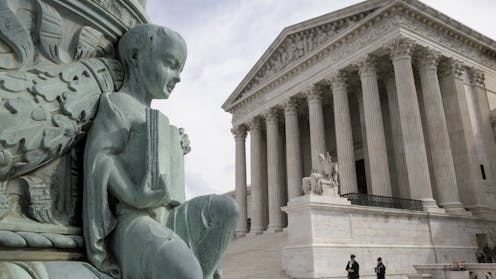Supreme Court upholds childproofing porn sites
- Written by Meg Leta Jones, Associate Professor of Technology Law & Policy, Georgetown University

The U.S. Supreme Court handed down a decision[1] on June 27, 2025, that will reshape how states protect children online. In a case assessing a Texas law requiring age verification to access porn sites, the court created a new legal path that makes it easier for states to craft laws regulating what kids see and do on the internet.
In a 6-3 decision, the court ruled[2] in Free Speech Coalition Inc. v. Paxton[3] that Texas’ law obligating porn sites to block access to underage users is constitutional[4]. The law requires pornographic websites to verify users’ ages – for example by making users scan and upload their driver’s license – before granting access to content that is deemed obscene for minors but not adults.
The majority on the court rejected both the porn industry’s argument for strict scrutiny[5] – the toughest legal test that requires the government to prove a law is absolutely necessary – and Texas’ argument for mere rational basis review[6], which requires only a rational connection between the law’s legitimate aims and its actions. Instead, Justice Clarence Thomas’ opinion established intermediate scrutiny, a middle ground that requires laws to serve important government interests without being overly burdensome, as the appropriate standard.
The court’s reasoning hinged on characterizing the law as only “incidentally” burdening adults’ First Amendment rights. Since minors have no constitutional right to access pornography, the state can require age verification to prevent that unprotected activity. Any burden on adults is, according to the ruling, merely a side effect of this legitimate regulation.
The court also pointed to dramatic technological changes since earlier similar laws were struck down in the 1990s and early 2000s. Back then, only 2 in 5 households had internet access[7], mostly through slow dial-up connections on desktop computers. Today, 95% of teens carry smartphones[8] with constant internet access to massive libraries of content. Porn site Pornhub[9] alone published over 150 years of new material[10] in 2019. The court argued that earlier decisions “could not have conceived of these developments,” making age verification more necessary than judges could have imagined decades ago.
More importantly for future legislation, the court embraced an “ordinary and appropriate means” doctrine: When states have authority to govern an area, they may use traditional methods to exercise that power. Since age verification is common for alcohol and tobacco, tattoos and piercings, firearms, driver’s licenses and voting, the court held that it’s similarly appropriate for regulating minors’ access to sexual content.
The key takeaway: When states are trying to keep kids away from certain types of content that kids have no legal right to see anyway, requiring age verification is an ordinary and appropriate way to enforce that boundary.
References
- ^ handed down a decision (19thnews.org)
- ^ court ruled (www.supremecourt.gov)
- ^ Free Speech Coalition Inc. v. Paxton (www.scotusblog.com)
- ^ is constitutional (www.washingtonpost.com)
- ^ strict scrutiny (www.law.cornell.edu)
- ^ rational basis review (www.law.cornell.edu)
- ^ 2 in 5 households had internet access (abcnews.go.com)
- ^ 95% of teens carry smartphones (www.pewresearch.org)
- ^ Pornhub (www.cbc.ca)
- ^ over 150 years of new material (www.pornhub.com)
- ^ Children’s Online Privacy Protection Act (www.ftc.gov)
- ^ Age-Appropriate Design Code (leginfo.legislature.ca.gov)
- ^ banned kids under 14 (www.nbcnews.com)
- ^ App Store Accountability Act (www.congress.gov)
Authors: Meg Leta Jones, Associate Professor of Technology Law & Policy, Georgetown University
Read more https://theconversation.com/supreme-court-upholds-childproofing-porn-sites-260052

